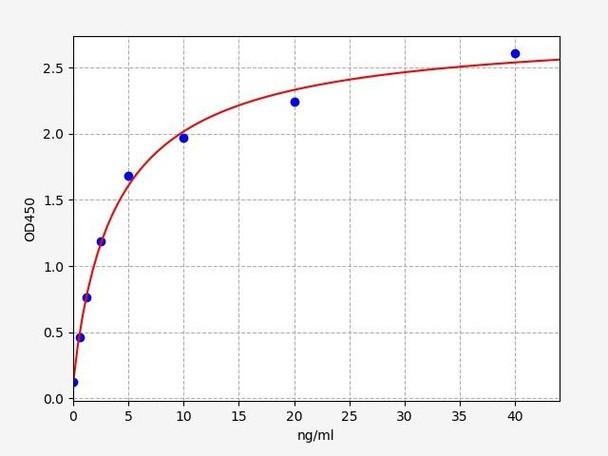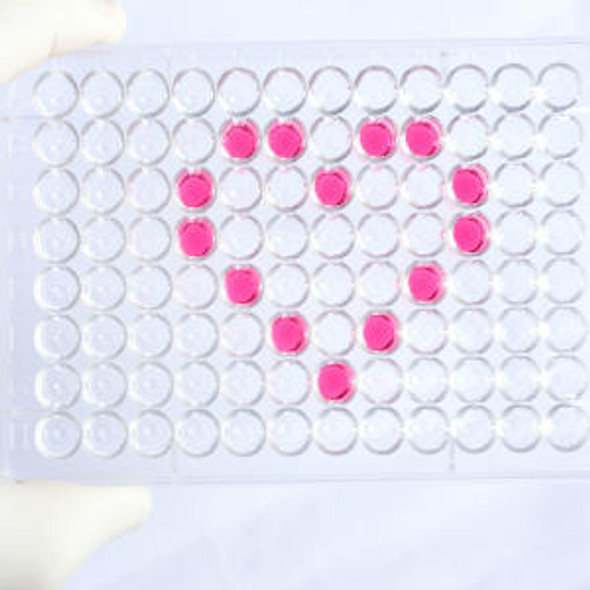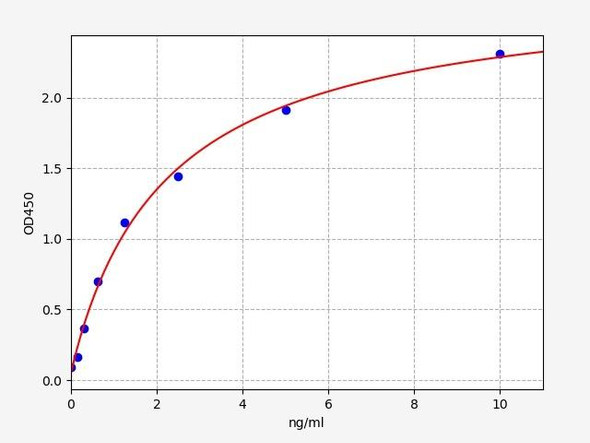Human PI3K(Phosphotylinosital 3 Kinase) ELISA Kit
- SKU:
- HUFI03114
- Product Type:
- ELISA Kit
- Size:
- 96 Assays
- Uniprot:
- P42336
- Sensitivity:
- 0.375ng/ml
- Range:
- 0.625-40ng/ml
- ELISA Type:
- Sandwich
- Synonyms:
- PI3K
- Reactivity:
- Human
Description
| Product Name: | Human PI3K(Phosphotylinosital 3 Kinase) ELISA Kit |
| Product Code: | HUFI03114 |
| Size: | 96 Assays |
| Alias: | PI3K |
| Detection method: | Sandwich ELISA, Double Antibody |
| Application: | This immunoassay kit allows for the in vitro quantitative determination of Human PI3K concentrations in serum plasma and other biological fluids. |
| Sensitivity: | 0.375ng/ml |
| Range: | 0.625-40ng/ml |
| Storage: | 4°C for 6 months |
| Note: | For Research Use Only |
| Recovery: | Matrices listed below were spiked with certain level of Human PI3K and the recovery rates were calculated by comparing the measured value to the expected amount of Human PI3K in samples. Enquire for more information. |
| Linearity: | The linearity of the kit was assayed by testing samples spiked with appropriate concentration of Human PI3K and their serial dilutions. The results were demonstrated by the percentage of calculated concentration to the expected. Enquire for more information. |
| CV(%): | Intra-Assay: CV<8% Inter-Assay: CV<10% |
| Component | Quantity | Storage |
| ELISA Microplate (Dismountable) | 8×12 strips | 4°C for 6 months |
| Lyophilized Standard | 2 | 4°C/-20°C |
| Sample/Standard Dilution Buffer | 20ml | 4°C |
| Biotin-labeled Antibody(Concentrated) | 120ul | 4°C (Protect from light) |
| Antibody Dilution Buffer | 10ml | 4°C |
| HRP-Streptavidin Conjugate(SABC) | 120ul | 4°C (Protect from light) |
| SABC Dilution Buffer | 10ml | 4°C |
| TMB Substrate | 10ml | 4°C (Protect from light) |
| Stop Solution | 10ml | 4°C |
| Wash Buffer(25X) | 30ml | 4°C |
| Plate Sealer | 5 | - |
Other materials and equipment required:
- Microplate reader with 450 nm wavelength filter
- Multichannel Pipette, Pipette, microcentrifuge tubes and disposable pipette tips
- Incubator
- Deionized or distilled water
- Absorbent paper
- Buffer resevoir
| Uniprot | P42336 |
| UniProt Protein Function: | PIK3CA: Phosphoinositide-3-kinase (PI3K) that phosphorylates PtdIns (Phosphatidylinositol), PtdIns4P (Phosphatidylinositol 4- phosphate) and PtdIns(4,5)P2 (Phosphatidylinositol 4,5- bisphosphate) to generate phosphatidylinositol 3,4,5-trisphosphate (PIP3). PIP3 plays a key role by recruiting PH domain-containing proteins to the membrane, including AKT1 and PDPK1, activating signaling cascades involved in cell growth, survival, proliferation, motility and morphology. Participates in cellular signaling in response to various growth factors. Involved in the activation of AKT1 upon stimulation by receptor tyrosine kinases ligands such as EGF, insulin, IGF1, VEGFA and PDGF. Involved in signaling via insulin-receptor substrate (IRS) proteins. Essential in endothelial cell migration during vascular development through VEGFA signaling, possibly by regulating RhoA activity. Required for lymphatic vasculature development, possibly by binding to RAS and by activation by EGF and FGF2, but not by PDGF. Regulates invadopodia formation in breast cancer cells through the PDPK1- AKT1 pathway. Participates in cardiomyogenesis in embryonic stem cells through a AKT1 pathway. Participates in vasculogenesis in embryonic stem cells through PDK1 and protein kinase C pathway. Has also serine-protein kinase activity: phosphorylates PIK3R1 (p85alpha regulatory subunit), EIF4EBP1 and HRAS. Heterodimer of a catalytic subunit PIK3CA and a p85 regulatory subunit (PIK3R1, PIK3R2 or PIK3R3). Interacts with IRS1 in nuclear extracts. Interacts with RUFY3. Interacts with RASD2. Interacts with APPL1. Interacts with HRAS1 and KRAS. Interaction with HRAS1/KRAS is required for PI3K pathway signaling and cell proliferation stimulated by EGF and FGF2. Belongs to the PI3/PI4-kinase family. |
| UniProt Protein Details: | Protein type:Motility/polarity/chemotaxis; Oncoprotein; EC 2.7.11.1; EC 2.7.1.153; Kinase, lipid; Carbohydrate Metabolism - inositol phosphate Chromosomal Location of Human Ortholog: 3q26.3 Cellular Component: lamellipodium; plasma membrane; phosphoinositide 3-kinase complex; cytosol Molecular Function:protein serine/threonine kinase activity; protein binding; phosphatidylinositol-4,5-bisphosphate 3-kinase activity; insulin receptor substrate binding; 1-phosphatidylinositol-3-kinase activity; kinase activity; protein kinase activator activity; ATP binding; phosphatidylinositol-4-phosphate 3-kinase activity; phosphoinositide 3-kinase activity Biological Process: epidermal growth factor receptor signaling pathway; platelet activation; phosphoinositide-mediated signaling; fibroblast growth factor receptor signaling pathway; nerve growth factor receptor signaling pathway; regulation of multicellular organism growth; glucose metabolic process; positive regulation of peptidyl-serine phosphorylation; T cell receptor signaling pathway; protein amino acid phosphorylation; vasculature development; phosphoinositide phosphorylation; positive regulation of protein kinase activity; phospholipid metabolic process; T cell costimulation; phosphatidylinositol biosynthetic process; protein kinase B signaling cascade; insulin receptor signaling pathway; innate immune response; endothelial cell migration; negative regulation of neuron apoptosis; angiogenesis; blood coagulation; vascular endothelial growth factor receptor signaling pathway; leukocyte migration; cardiac muscle contraction Disease: Cowden Syndrome 5; Gastric Cancer; Keratosis, Seborrheic; Breast Cancer; Lung Cancer; Ovarian Cancer; Congenital Lipomatous Overgrowth, Vascular Malformations, And Epidermal Nevi; Colorectal Cancer; Megalencephaly-capillary Malformation-polymicrogyria Syndrome; Hepatocellular Carcinoma; Nevus, Epidermal |
| NCBI Summary: | Phosphatidylinositol 3-kinase is composed of an 85 kDa regulatory subunit and a 110 kDa catalytic subunit. The protein encoded by this gene represents the catalytic subunit, which uses ATP to phosphorylate PtdIns, PtdIns4P and PtdIns(4,5)P2. This gene has been found to be oncogenic and has been implicated in cervical cancers. A pseudogene of this gene has been defined on chromosome 22. [provided by RefSeq, Apr 2016] |
| UniProt Code: | P42336 |
| NCBI GenInfo Identifier: | 126302584 |
| NCBI Gene ID: | 5290 |
| NCBI Accession: | P42336.2 |
| UniProt Related Accession: | P42336 |
| Molecular Weight: | ~ 110kDa |
| NCBI Full Name: | Phosphatidylinositol 4,5-bisphosphate 3-kinase catalytic subunit alpha isoform |
| NCBI Synonym Full Names: | phosphatidylinositol-4,5-bisphosphate 3-kinase catalytic subunit alpha |
| NCBI Official Symbol: | PIK3CA |
| NCBI Official Synonym Symbols: | MCM; CWS5; MCAP; PI3K; CLAPO; CLOVE; MCMTC; PI3K-alpha; p110-alpha |
| NCBI Protein Information: | phosphatidylinositol 4,5-bisphosphate 3-kinase catalytic subunit alpha isoform |
| UniProt Protein Name: | Phosphatidylinositol 4,5-bisphosphate 3-kinase catalytic subunit alpha isoform |
| UniProt Synonym Protein Names: | Phosphatidylinositol 4,5-bisphosphate 3-kinase 110 kDa catalytic subunit alpha; PtdIns-3-kinase subunit p110-alpha; p110alpha; Phosphoinositide-3-kinase catalytic alpha polypeptide; Serine/threonine protein kinase PIK3CA (EC:2.7.11.1) |
| UniProt Gene Name: | PIK3CA |
| UniProt Entry Name: | PK3CA_HUMAN |
*Note: Protocols are specific to each batch/lot. For the correct instructions please follow the protocol included in your kit.
Before adding to wells, equilibrate the SABC working solution and TMB substrate for at least 30 min at 37°C. When diluting samples and reagents, they must be mixed completely and evenly. It is recommended to plot a standard curve for each test.
| Step | Protocol |
| 1. | Set standard, test sample and control (zero) wells on the pre-coated plate respectively, and then, record their positions. It is recommended to measure each standard and sample in duplicate. Wash plate 2 times before adding standard, sample and control (zero) wells! |
| 2. | Aliquot 0.1ml standard solutions into the standard wells. |
| 3. | Add 0.1 ml of Sample / Standard dilution buffer into the control (zero) well. |
| 4. | Add 0.1 ml of properly diluted sample ( Human serum, plasma, tissue homogenates and other biological fluids.) into test sample wells. |
| 5. | Seal the plate with a cover and incubate at 37 °C for 90 min. |
| 6. | Remove the cover and discard the plate content, clap the plate on the absorbent filter papers or other absorbent material. Do NOT let the wells completely dry at any time. Wash plate X2. |
| 7. | Add 0.1 ml of Biotin- detection antibody working solution into the above wells (standard, test sample & zero wells). Add the solution at the bottom of each well without touching the side wall. |
| 8. | Seal the plate with a cover and incubate at 37°C for 60 min. |
| 9. | Remove the cover, and wash plate 3 times with Wash buffer. Let wash buffer rest in wells for 1 min between each wash. |
| 10. | Add 0.1 ml of SABC working solution into each well, cover the plate and incubate at 37°C for 30 min. |
| 11. | Remove the cover and wash plate 5 times with Wash buffer, and each time let the wash buffer stay in the wells for 1-2 min. |
| 12. | Add 90 µl of TMB substrate into each well, cover the plate and incubate at 37°C in dark within 10-20 min. (Note: This incubation time is for reference use only, the optimal time should be determined by end user.) And the shades of blue can be seen in the first 3-4 wells (with most concentrated standard solutions), the other wells show no obvious color. |
| 13. | Add 50 µl of Stop solution into each well and mix thoroughly. The color changes into yellow immediately. |
| 14. | Read the O.D. absorbance at 450 nm in a microplate reader immediately after adding the stop solution. |
When carrying out an ELISA assay it is important to prepare your samples in order to achieve the best possible results. Below we have a list of procedures for the preparation of samples for different sample types.
| Sample Type | Protocol |
| Serum | If using serum separator tubes, allow samples to clot for 30 minutes at room temperature. Centrifuge for 10 minutes at 1,000x g. Collect the serum fraction and assay promptly or aliquot and store the samples at -80°C. Avoid multiple freeze-thaw cycles. If serum separator tubes are not being used, allow samples to clot overnight at 2-8°C. Centrifuge for 10 minutes at 1,000x g. Remove serum and assay promptly or aliquot and store the samples at -80°C. Avoid multiple freeze-thaw cycles. |
| Plasma | Collect plasma using EDTA or heparin as an anticoagulant. Centrifuge samples at 4°C for 15 mins at 1000 × g within 30 mins of collection. Collect the plasma fraction and assay promptly or aliquot and store the samples at -80°C. Avoid multiple freeze-thaw cycles. Note: Over haemolysed samples are not suitable for use with this kit. |
| Urine & Cerebrospinal Fluid | Collect the urine (mid-stream) in a sterile container, centrifuge for 20 mins at 2000-3000 rpm. Remove supernatant and assay immediately. If any precipitation is detected, repeat the centrifugation step. A similar protocol can be used for cerebrospinal fluid. |
| Cell culture supernatant | Collect the cell culture media by pipette, followed by centrifugation at 4°C for 20 mins at 1500 rpm. Collect the clear supernatant and assay immediately. |
| Cell lysates | Solubilize cells in lysis buffer and allow to sit on ice for 30 minutes. Centrifuge tubes at 14,000 x g for 5 minutes to remove insoluble material. Aliquot the supernatant into a new tube and discard the remaining whole cell extract. Quantify total protein concentration using a total protein assay. Assay immediately or aliquot and store at ≤ -20 °C. |
| Tissue homogenates | The preparation of tissue homogenates will vary depending upon tissue type. Rinse tissue with 1X PBS to remove excess blood & homogenize in 20ml of 1X PBS (including protease inhibitors) and store overnight at ≤ -20°C. Two freeze-thaw cycles are required to break the cell membranes. To further disrupt the cell membranes you can sonicate the samples. Centrifuge homogenates for 5 mins at 5000xg. Remove the supernatant and assay immediately or aliquot and store at -20°C or -80°C. |
| Tissue lysates | Rinse tissue with PBS, cut into 1-2 mm pieces, and homogenize with a tissue homogenizer in PBS. Add an equal volume of RIPA buffer containing protease inhibitors and lyse tissues at room temperature for 30 minutes with gentle agitation. Centrifuge to remove debris. Quantify total protein concentration using a total protein assay. Assay immediately or aliquot and store at ≤ -20 °C. |
| Breast Milk | Collect milk samples and centrifuge at 10,000 x g for 60 min at 4°C. Aliquot the supernatant and assay. For long term use, store samples at -80°C. Minimize freeze/thaw cycles. |






